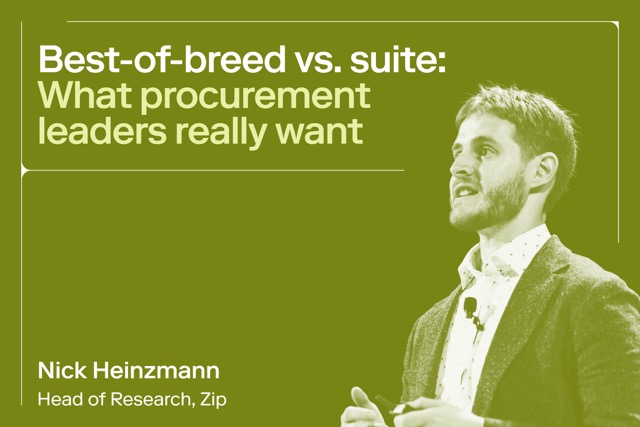
Vendor selection process: A comprehensive guide
Optimize your vendor selection process by learning these best practices.

In light of how AI and other procurement trends are rapidly changing the way businesses select vendors, is your process still effective?
The vendor selection process helps companies identify, evaluate, and contract with essential suppliers. It’s important to thoroughly vet the companies you work with to manage costs, maintain quality, and promote long-term growth.
In this guide, we’ll cover how to create a well-orchestrated vendor selection process and outline key strategies to optimize it, ensuring your business makes informed decisions to find the right partners and builds a strong foundation for lasting success.
What is a vendor?
Vendors, also known as suppliers, are third-party groups that provide products and services to businesses. Vendor services depend on business needs and can include options like catering, IT support, landscaping, and software. Vendors are usually grouped into four categories:
- Manufacturer
- Retailer
- Wholesaler
- Service provider
You can pay vendors upfront or through invoices after goods and services are delivered. Some vendors offer recurring goods or services on a daily, weekly, monthly, or yearly basis.
Hiring vendors can often be more cost-effective than creating in-house positions, offering savings on employee benefits and the ability to adjust capacity as demand changes.
Steps in the vendor selection process
Refer to the following steps as you create or iterate upon your vendor selection process.

1. Identify business needs and requirements
In this stage, procurement teams assess business needs and vendor requirements, asking questions like:
- What types of goods or services does our business need?
- How much are we willing to pay for each vendor?
- Do we need this good or service on a one-time or recurring basis?
The answers to these questions will help you determine your search parameters and priorities.
2. Research potential vendors
The next step is researching multiple options for each good or service you are trying to source. You can find vendors through different methods, including online supplier directories or marketplaces, industry associations and professional networks, and in-person events like trade shows and business mixers.
3. Establish vendor selection criteria
Narrow your list of vendors by establishing criteria based on your business needs and requirements. Some examples of vendor selection criteria include:
- Price
- Product/service quality
- Reliability
- Compatibility with your values
- Customer service
Depending on your goals, you can assign more weight to certain factors like price.
Once you've defined your selection criteria and their weight, eliminate vendors that don't qualify. Then, rank the remaining options by how well they fulfill those requirements.
4. Send request for proposal (RFP) or request for quotation (RFQ)
Send a request for proposal (RFP) or request for quotation (RFQ) to the vendors that meet your selection criteria. These detailed documents should include:
- Company details: Provide context about your organization, including your goals and needs.
- Vendor requirements: What qualifications and experience does the vendor need? This might be knowledge of a specific coding language or prior work on paid media marketing campaigns.
- Proposal evaluation criteria: How will the proposals be evaluated and scored?
- Vendor questions: Crafting the right questions to ask vendors is the key to finding the right fit. Be sure to include open-ended questions that allow vendors to demonstrate their expertise and approach.
- Contact details: What is the preferred submission process for proposals (online portal, email, or in person)? Be thorough to ensure you’re working within the vendor’s preferences.
While RFQs are primarily used for price comparison, RFPs allow for a more thorough evaluation of vendor capabilities, making them ideal for technically complex projects.

5. Evaluate vendor proposals
The vendor evaluation process begins once all your proposals have been returned. A vendor selection scorecard allows procurement teams to quantify the attributes of potential vendors based on predefined criteria included in your RFP/RFQ. You might include the following on your scorecard:
- Financial stability: Assess a vendor’s financial health to ensure they can deliver long-term service without risk.
- Quality: Measure the quality of the products or services offered, ensuring they meet the company's standards by reviewing case studies or online testimonials.
- Delivery capabilities: Evaluate the vendor’s ability to meet deadlines and manage logistics effectively.
- References: Verify the vendor's reputation and reliability through feedback from previous clients.
- Total cost of ownership (TCO): Consider all costs associated with a vendor, from acquisition through the lifecycle of the products or services.
When comparing proposals, vendor evaluation criteria should balance qualitative and quantitative factors. This is also the time to look for red flags like unrealistic pricing, lack of relevant experience, or vague details. If you have any questions about the proposal, follow up with each vendor.
By the end of this process, you should be left with a shortlist of qualified vendors that fit your needs.
6. Conduct vendor interviews and demos
With your list of final options, the next step is to conduct interviews with potential vendors and request demos (when applicable).
Vendor interviews are opportunities to gather more information about each vendor and determine the best fit for your business. Interviews can be conducted over the phone, in person, or through video calls. Create a list of questions that build upon topics discussed in the RFP/RFQ, or ask any new questions you may have from their proposal.
Demos are opportunities to see a product or service in action through live demonstrations, pre-recorded videos, or trial versions. They should be evaluated based on criteria like ease of use, functionality and features, performance and reliability, integration with existing systems, and user experience.
7. Assess vendor capabilities and compliance
Vendor verification is essential before entering into a contract, similar to the importance of background checks when hiring an employee. You need to confirm that the vendor can deliver on their promises and thoroughly review their legal and financial standing.
This process can include document reviews, certification checks, and background checks. It may also involve site visits, reference checks, and the use of third-party auditors.
8. Negotiate terms and pricing
Once you feel comfortable with a vendor's capabilities and compliance, you can move on to the negotiation stage.Talking points should include:
- Pricing
- Scope of work
- Contract terms
- Service level agreements (SLAs)
9. Make the final selection
This is the decision-making stage, where you select the vendor that best meets your requirements. Key stakeholders—usually management or operations team members—should make the final decision after reviewing all relevant information, including proposals, evaluation scores, interview notes, demo feedback, and reference checks.
You may have to secure approval from internal stakeholders before finalizing the vendor selection. In this case, provide detailed documentation to justify your decision.
Once you have reviewed the final contract and determined that the terms and conditions are acceptable for your business, it’s time to sign the contract.
10. Monitor performance and build relationships
Vendor performance should be measured regardless of whether the business relationship is a one-time contract or an ongoing partnership.
Ensure vendors have fulfilled their contractual obligations by comparing deliverables to the outlined contract terms.
Keep lines of communication open and provide feedback frequently for strong supplier relationship management. If there are any issues with their performance, work together to find amicable solutions.
Best practices for choosing vendors
If you want a successful procurement outcome, you need to select the right vendor. Here are some best practices to help you find the right fit for your business.
- Determine your appetite for risk: If you are risk-averse, target vendors with established track records and stability. If you are risk-tolerant, consider newer vendors that offer innovative but less-proven solutions.
- Conduct thorough market research: Gather comprehensive information about potential vendors, including average pricing, capabilities, and industry reputation. This research helps you identify the right partner for your needs.
- Evaluate vendors based on quality signals, not just price: While vendor price is a key consideration, data-driven insights such as quality metrics, customer satisfaction, and financial health should also be factored into the selection process.
- Check references and past performance: Don't just take a vendor's claims at face value. Verify their capabilities by checking past performance data and client testimonials and contacting references for firsthand accounts of their experience.
- Consider contract transparency and flexibility: Before signing a contract, thoroughly review it to ensure the details are concise, clearly define the scope of work, and allow flexibility to make adjustments during your engagement.
- Establish a strong vendor relationship management strategy: Vendor relationships start at first contact and are built on open communication, clear expectations, and a willingness to collaborate on challenges and opportunities for growth. Always put your best foot forward—you never know who will become a long-term partner.
Qualitative Assessment Methods:
- Vendor reputation and references: Assess the vendor's standing within the industry and gather feedback from their current and past clients. This provides a real-world perspective on what it is like to work with the vendor.
- Alignment with organizational values: Ensure that the vendor’s business practices and ethical standards are in line with your company’s culture. Without this alignment, it will be difficult to foster a strong, enduring partnership.
- Innovation and strategic value: Evaluate how well a vendor’s offerings align with your strategic goals, especially their capability to provide innovative solutions that provide value beyond the immediate needs.
Zip's AI-powered procurement orchestration platform simplifies the process of extracting essential information from vendor documents. These kinds of intelligent automations reduce manual effort and minimizes the likelihood of errors, making the evaluation process significantly more efficient.
Zip also offers robust spend analytics tools that provide detailed insights into spending patterns, vendor performance data, and potential cost-saving opportunities. With robust oversight and analysis, procurement leaders are empowered to make informed, strategic decisions that outcomes across the entire procurement process.
Vendor selection criteria
A procurement team is only as effective as their process. This is why it’s so important to set clear, objective vendor selection criteria from the start. These criteria serve as the foundation for unbiased decision-making and ensure that vendor selection aligns strategically with broader organizational goals. Criteria categories should include:
- Quality
- Reliability
- Experiences and capabilities
- Scalability
- Pricing
- Financial stability
- Risk management
- Regulatory compliance
- Customer service
- Cultural fit
- Innovation
The following vendor selection criteria checklist covers recommendations of what to measure when evaluating potential vendors.

Example of vendor selection
The following example shows how to use the vendor selection process to find the right fit for your business.
Let's say a growing e-commerce company needs a new platform to handle increased traffic, expand product offerings, and improve customer experience. Here's how their vendor selection process might unfold:
- Identify business needs and requirements: The organization has a monthly budget of $5,000-$10,000 and requires a platform that can handle increased traffic and scalable product offerings. The platform must be mobile-friendly, have a secure payment gateway, and include an analytics dashboard.
- Research potential vendors: The organization identifies potential vendor options through online research and networking at a local industry mixer.
- Establish vendor selection criteria: To narrow down the options, the organization eliminates potential vendors that are too expensive or lack necessary features, such as an analytics dashboard.
- Request for proposal: The procurement team sends an RFP to potential vendors. It contains details about the company, their requirements for an e-commerce platform, the proposal ranking criteria, and questions about the vendor's service.
- Evaluate vendor proposals: Vendor proposals are ranked by the criteria mentioned in the RFP and narrowed down to three options: Shopiverse, Vendr, and Ecomify.
- Conduct vendor interviews and demos: The procurement team conducts interviews, including live walk-throughs of the platform, with all potential vendors.
- Assess vendor capabilities and compliance: Each vendor option undergoes a thorough background check to investigate their financial and legal history and identify any potential issues.
- Negotiate terms and pricing: The procurement team and the vendors negotiate the terms and pricing for a one-year contract.
- Make the final selection: Shopiverse was selected as the vendor after a thorough review of proposals, interviews, and background checks. Confident in their decision, the organization signs a final contract.
- Monitor performance and build relationships: The company monitors Shopiverse’s performance by tracking key metrics like on-time delivery rates, order accuracy, and customer satisfaction. They maintain regular communication to address issues and discuss future needs and opportunities.
Optimize vendor selection with Zip
Centralized vendor management software improves the vendor procurement process by simplifying data collection, consolidating vendor data, and automating task management. Zip streamlines this process from beginning to end.
Leveraging Zip’s solutions can dramatically improve the efficiency and outcomes of your vendor selection and management processes. Whether you are dealing with a complex project management scenario or looking for the most suitable vendor, Zip provides the tools and insights necessary to succeed.
If you’re ready to find out how Zip can ensure that your organization remains adaptable, competitive, and at the cutting edge of what’s possible, we’d like to invite you to request a demo today.
FAQ
Still have questions about the vendor selection process? Find answers below.
What is the importance of vendor selection?
Effective vendor selection is vital because it impacts the cost, quality, and success of the goods or services you receive.
What are vendor types?
Vendors are often categorized into one of four categories:
- Manufacturer: Uses raw materials to create finished goods like cars, appliances, furniture, clothing, and food
- Retailer: Sells finished products directly to consumers online or in-store
- Wholesaler: Sells large quantities of finished goods at discounted rates to retailers or other businesses
- Service provider: Offers services to businesses or individuals such as cleaning, marketing, IT, or financial services
What is the RFP for vendor selection?
A request for proposal (RFP) is a document businesses use to communicate their needs and requirements to potential vendors. It’s used to solicit bids for goods or services.

Maximize the ROI of your business spend

Enter your business email to keep reading






.webp)


